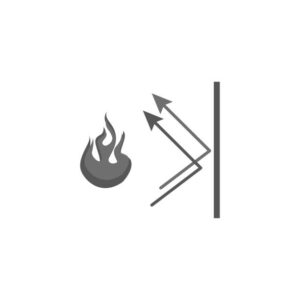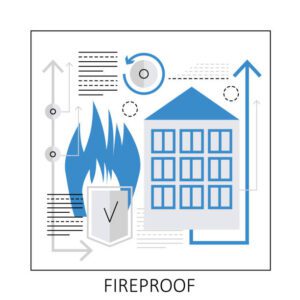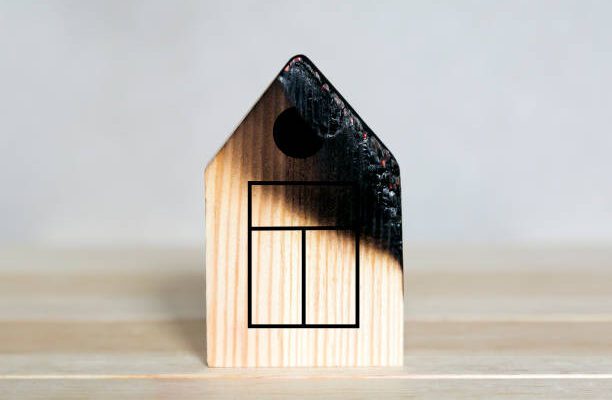Any home owner would be wise to increase their home’s fire resistance. If you reside in a region where wildfires are often, it’s an especially wise move. You can take measures to build your new home using materials that will smother fires. If you want to make your current home more fireproof, you may do it by reducing the number of fire sources there. This will help shield your property from internal fires.
Fireproof barrier
 (Photo from iStock)
(Photo from iStock)
Making a perimeter around your property that is essentially fireproof is one technique to safeguard it from a fire. Driveways and patios, which are made of concrete and gravel, aid in forming a break line. You can also utilize small, close-growing plants that are resistant to fire.
California lilac, ornamental strawberry, yellow ice plant, French lavender, and California fuchsia are a few examples of fire-resistant plants. Look for plants with a high moisture content and low resin content.
Make sure fire trucks can access your home
Firefighters cannot extinguish the fire if a fire truck cannot reach your home. You must make sure that even your driveway is sturdy enough to support a fire truck because a fire truck needs a good path to reach your home. Having a decent location to turn the truck around also helps. Additionally, consider anything that restricts entrance, like a gate. If you’re in a region that is prone to fires, it is best to keep access open.
Use fireproof materials on roof
 (Photo from iStock)
(Photo from iStock)
While the primary building material is crucial, you also need to be mindful of the materials you use for your siding and roof. For example, you can utilize siding made of brick, stucco, stone, tile, metal, or even concrete for your roof.
If a wood roof is absolutely necessary, check to see if the shingles have been treated to resist fire.
Remove debris from roof
As much as a mile can be covered by a fire’s embers. They might touch down on your roof. Even though your roof is composed of flame-resistant materials, it can catch fire if there is trash there. It’s a good idea to frequently clean your gutters.
In order to check for soot accumulation, get your chimney cleaned once a year as well.
Overhead power lines
You should make sure that any electrical lines that are close to or above your property won’t be damaged by falling tree limbs. Any tree limbs that are close to a power line should be kept cut back.
Keep an eye out for limbs that dangle over your power lines or that are beginning to grow in between them. The majority of power suppliers will cut your trees for you.
Give away what you don’t need
The simpler it is for a fire to spread, the more things you have in your house. Make sure you’re only keeping items in your home that you find useful, whether for practical reasons or for aesthetic ones, by going through your belongings. For instance, it’s time to give or throw away any clothing you haven’t worn in a year.
Take out candles
Candles can cause fires because they are prone to being knocked over. Additionally, the flame may spread to surrounding fabrics or be topped by an object. Use oil diffusers instead, such bamboo sticks, or go with a wax-warming device. Although electrical sources have the potential to catch fire, they are typically safer than open flames.
Practice electrical safety
 (Photo from iStock)
(Photo from iStock)
You either have an issue with your electrical system or you are overloading your outlet if you frequently trip the breaker or blow a fuse. If the issue persists despite using less of that outlet, you should contact an electrician.
Fires may result from poor electrical systems. Do not also run cords underneath rugs.
Replace faulty appliances
It is best to replace a lamp or other electronic item if it sparks, produces odd noises, or smells odd. Faulty appliances may cause fires in your home by emitting sparks that ignite a fire.
Keep lamps away from drapes
 (Photo from iStock)
(Photo from iStock)
Lamp and nightlight light bulbs can heat up to the point that they can catch fire, especially when used near fabric. Make sure that nothing, especially curtains or bed sheets, is too close to a lamp’s bulb.
Use furniture made from natural material
The synthetic materials used in contemporary furniture are generated from petrochemicals. These furnishings burn quickly and emit noxious gases when lit. Natural furnishings burn more slowly and do not give off harmful fumes.
Check space heaters
Space heaters can be dangerous, especially the older models with open heating elements. A heater should not be placed in a location where a child or pet could tip it over. Also, keep anything flammable far away from heaters.
Install fire alarms
The risk of death in a fire for your family is reduced by 50% by smoke alarms. One should be present on each floor of your home as well as in each bedroom. The smoke will rise to the detectors, so mount them high on the wall or ceiling.
Check fire alarms time to time
Make sure your fire alarms are operational by checking them twice a year. You’ll need to swap out the battery if they’re not. You might need to call an electrician to fix a fire alarm that is wired into your electrical system.
Keep fire extinguisher at home
Make sure to maintain at least one fire extinguisher in your home, if you don’t already. Since many fires begin in the kitchen, it is a good idea to keep one there. Ensure that everyone in the home has easy access to it, that they are all old enough to use it, and that it is conveniently located.
If your home is multi-story, you should also have a fire extinguisher on each floor.
Always be prepared
 (Photo from iStock)
(Photo from iStock)
You should be familiar with the best escape routes before a fire ever breaks out in your home. Make an effort to establish at least two exits for each space. Additionally, confirm the viability of your escape routes. For instance, if a window doesn’t open, you might not be able to escape via it.
Create a meeting place for your family that you can all go to in case of an emergency, such a fire, such as the mailbox.





19 Comments on “Tips to make your home fireproof”